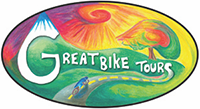New Zealand by Bike – Four simple words…yet they so perfectly define the ideal active vacation. Please come join us for one of our spectacular New Zealand bicycle tours. Over the course of 13 days our biking holidays will cover three distinct areas of the country, as outlined below. While you are reading, please imagine yourself in the photos; follow along with the map; and then call us to reserve your [bicycle] seat on one of our fabulous New Zealand bicycle tours!
New Zealand Bike Tours
Detailed Itinerary
Days 1, 2, and 3 — The Otago Rail Trail
We start our New Zealand active vacation in Dunedin, a university town with a heavy Scottish influence. Before leaving town we’ll try and get our first wildlife fix with a visit to the nearby Otago Peninsula to see the blue-eyed and yellow-eyed penguins, sea lions, fur seals, and the world’s only mainland breeding colony of Royal Northern Albatross.


We start off all of our NZ biking holidays with a scenic train ride, heading inland from Dunedin through the Taieri River Gorge. Our journey will take us through ten tunnels and across a dozen stone and wrought iron viaducts, with great views of sheer rock cliffs, dark peaty pools, and wild whitewater.
Oops, almost forgot, this is a bike vacation! So, for the next three days we will ride west on a flat rail trail, a nice gentle start to the tour (and a good way to practice riding on the left side). Savor the peace and solitude of the Otago rail trail as we cruise through classic big-sky country, visiting old gold-mining towns, historical rural villages, and other hidden treasures not seen from the main road.
For three days you will be far, far away from the stresses and pace of modern time. Your biggest responsibility will be to open and close the occasional gate on the rail trail, and your constant companions will be Romney sheep and Magpies, along with hillsides carpeted with lilac-colored wild thyme, blue borage, purple linaria, lupines and poppies.
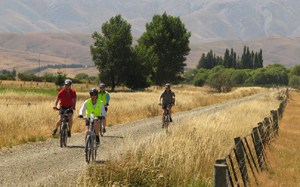
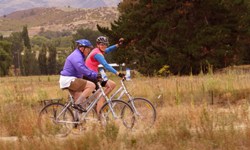
A few bridges, tunnels, and viaducts later, we find ourselves deep in the heart of Central Otago. We cycle through rugged terrain found only in this region of NZ. We pass intriguing natural schist-rock sculptures (known as tors) that perforate the landscape. Sheltered by the Southern Alps, the climate here is hot and dry, and the landscape is painted with browns, golds, and reds (unlike most of New Zealand, which is greener than green). It is in this region that director Peter Jackson created the village of Rohan for his Lord of the Rings movies.
This continental climate accounts for the profusion of orchards and vineyards, and we will visit as many as we can. The area around Cromwell is known as the “Fruit Bowl” of the South, and roadside stands will tempt us with their luscious peaches, plums, nectarines, apricots, and cherries. Central Otago is also famous for its wines, particularly Pinot Noir. The local terroir is also perfect for Riesling, Pinot Gris, and sparking wine. With over 80 vineyards to its name, Central Otago is the most southerly wine producing region in the world. Visit as many as you like, assuming you can still cycle straight!
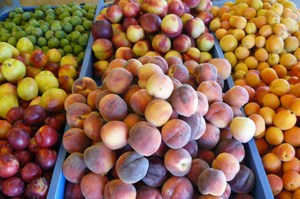
Days 4, 5, and 6 — Lord of the Rings Scenery, Wanaka,
Queenstown, and Milford Sound
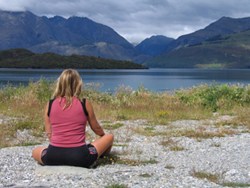
Instead of gravitating towards the more-famous (and frantic) Queenstown, the local folks recommend that we spend our next three nights in the town of Wanaka. And so we will. That will give us two full days to explore everything that this gorgeous region has to offer. Wanaka has been described as the “laid-back cousin of Queenstown” (New York Times). That front-page article went on to say that: “Wanaka is similarly situated at the base of chiseled mountains on the shores of an azure lake, but without the same preponderance of in-your-face adventure advertising. It has plenty of hotels and activities, but not so many that they detract from the natural splendor of the area.”
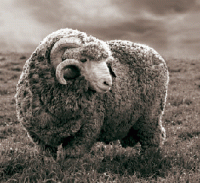
Staying in one place for three nights will give us the chance to catch our breath after the exhilaration of the rail trail. On our first full day in the region (Day 5) we’ll offer several options, including relaxing by the lake under the huge shady trees, sitting at a lakeside café and watching the world go by, strolling over to the local winery, enjoying a massage, or maybe head back to the hot tub with a cocktail! If such extreme relaxation is not your cup-of-tea then we have other things up our sleeves, including a lovely bike ride through the high-country merino sheep lands, where some of the ranches stretch over 30,000 acres with 10,000 head of sheep. A number of scenes from the Lord of the Rings were filmed in this region.
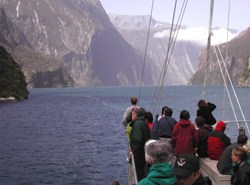
So, we still have one more full day (Day 6) to spend in this breathtaking region. This is day of many choices. Some folks opt for skydiving, while others head to the famous Milford Sound for a boat cruise on the fiord. Along with Norway and Chile, New Zealand has some of the most spectacular fiords in the world. Of the 14 fiords in New Zealand, Milford Sound is the most well-known. It is also part of the local World Heritage Area, and with good reason.
For all the hustle and bustle that is Queenstown, you should not leave New Zealand without visiting this special place. Defying the advice of our elders, we will also offer a day trip to Queenstown on Day 6. Make sure to bring your camera with you, as Queenstown is located in a picture-perfect setting. The small downtown area is nestled on the shores of the sapphire-blue Lake Wakatipu, and is surrounded on three sides by the soaring indigo heights of the mountain range known as The Remarkables.
Hailed as the Adventure Capital of the World, Queenstown has a long tradition of providing exciting and innovative activities. There are hundreds of different adventure tours to choose from, including para-gliding, skydiving, and horseback riding.
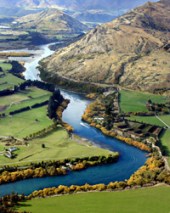
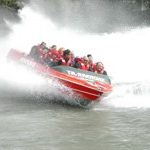
Simon says… “do the Canyon Swing (the world’s highest rope swing), take a ride on a jet boat, or throw yourself off a perfectly good bridge (the historic Kawarau Bridge was the world’s first commercial bungy site (1988).” With bungy, you can jump or dive forwards, backwards, by yourself or with a friend. Some have called it “the quickest personal growth experience ever.” Or on a more mellow note, you can visit Queenstown’s Kiwi Birdlife Park, kayak on the lake, ride the Skyline gondola, or take a guided tour of Lake Wakatipu aboard a stately steam-powered ship. And of course, “retail therapy” is always an essential part of any visit to Queenstown! And with more than 100 cafés & restaurants to choose from, Queenstown is a genuine delight for the taste buds.
OK, it’s time to take stock of all that we have experienced so far. WOW! This sure is the best active vacation ever. But wait, there’s MORE! We’re only half way through!
Days 7 to 13 — The West Coast: A World Heritage Area of Rainforests, Glaciers, and Wild Beaches
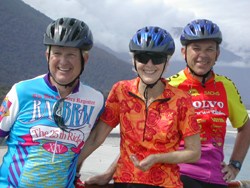
or the next four days we will be pedaling through Southwest New Zealand, a region that the United Nations has designated as a World Heritage Area in recognition of “its excellent natural features, its exceptional beauty, and its role in demonstrating the earth’s evolutionary history.” This World Heritage Area stretches from Fiordland National Park in the south to Okarito Lagoon in the north, and to Mount Aspiring National Park in the east. We will be exploring these areas over the next four days, along with their award-winning snow-capped mountains, grinding glaciers, rainforests, waterfalls, surging rivers, tussock grasslands, brooding lakes, wetlands, and wild coastline.
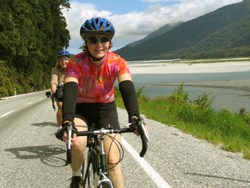
Cycling west from Wanaka, we travel alongside two massive lakes that were formed 20,000 years ago when the glaciers retreated, leaving behind a striking landscape of immense U-shaped valleys, terraces, escarpments, and roche moutonnées. These lakes reach an astonishing depth of almost 1,300 feet. From our bikes, the views of these lakes & mountains are to-die-for, and we envy the lucky few who live here. It is not too long before get our first glimpse of the stunning snow-capped peaks of Mount Aspiring National Park, with its Matterhorn-like mountains and over 100 glaciers.
We continue our bike ride through high country grasslands, and soon begin to alternate between gentle undulations over open river flats and short uphills through silver beech forest. After a final 4-km push we reach the top of Haast Pass, the lowest pass through the Southern Alps. From here it is 60 km to the west coast—most of it downhill! This bike ride is one of the best in New Zealand. As we cruise merrily along, it dawns on us that we are descending into a completely different world. This place is hauntingly beautiful, with old-growth rain-forest interspersed with cascading waterfalls and swampy lagoons. The flaming-red rimu flower thrives in the forest around us, and strange birdlife abounds with fantail, bell-bird, kea, kaka, and kiwi. Our senses are on overload, but in a pleasant way.
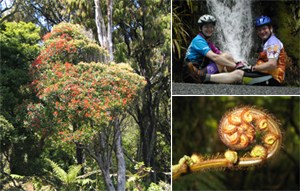
What a difference a mountain range makes. Hemmed in by the Tasman Sea and the peaks of the Southern Alps, the West Coast is like nowhere else in New Zealand. Isolated from the rest of New Zealand, the “Coasters” have developed a distinctive culture of their own. First came the Māori people seeking sacred pounamu (NZ jade, or greenstone), followed by Europeans in search of gold in the 1860s, many of whom stayed on to start farming, forestry, fishing, and tourism businesses.
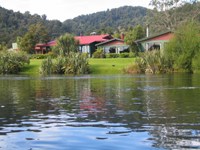
Our destination for the next two nights is the Wilderness Lodge at Lake Moeraki. And although we always offer a daily cycling option, we suggest that you spend your layover day relaxing at this very special oasis of warm hospitality and naturalist-led activities.
The Lodge is smack-in-the-middle of the World Heritage Area (WHA), and the rainforest here is quite exquisite. This WHA is the world’s largest fully-protected remnant of the ancient southern super-continent of Gondwana, and contains the best remaining examples of podocarp forests (a.k.a. southern conifers), also known as “dinosaur” forests because they existed at the same time as the dinosaurs. These trees give the forest a very ancient and primeval feel, a land before time—Middle Earth in fact. You’ll feel like you’re on the film set from Jurassic Park. Take a wander through this classic three-level rainforest. The very tall proud trees are the kahikatea. They are festooned with hanging mosses, vines, mistletoe, and orchids, while opportunist ferns climb up their trunks from the forest floor. A 40-minute walk brings you to secluded Monroe’s Beach where you sometimes see fur seals and a breeding colony of crested penguins (July to November).
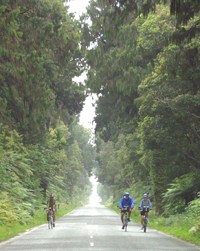
At this Lodge you can check several things off your must-do list: after dark, view the night sky up above (including the Southern Cross), the glow worms down below, all while listening to the hoot of the native owl known as the Morepork. During the day, toy with the inquisitive kea parrots outside your room, or borrow a fishing rod, kayak, or rowboat and head out on Lake Moeraki.
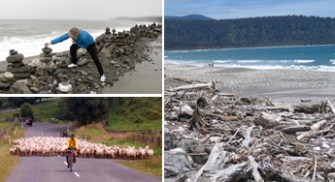
On Day 9 we continue our journey up the West Coast, and it is easy to see why the Lonely Planet guide called our route “one of the planet’s 10 best road trips.” We alternate between riding through cool lush temperate rainforest, open pastureland, and past broad sweeps of untamed beaches and dramatic cliffs along the Tasman Sea. Teal-colored rivers race each other on their short and wild journey to the sea. Around these parts, the lakes, rivers, forests, and beaches are as pure as you will find anywhere.
On our layover day in the Franz Josef area (Day 10), you may choose from a variety of optional activities, including the Glacier Hot Pools and Massage. We will offer a vigorous bike ride over the Fox Hills for those that want to punish themselves, but we strongly recommend that you try and spend some face time with the glacier itself… to touch the ice, and be touched by it, to listen closely to the glacier creaking and cracking as it squeezes down the valley. The early Māori knew Franz Josef Glacier as Ka Roimato o Hine Hukatere (Tears of the Avalanche Girl). Legend tells of a girl losing her lover, who fell from the local peaks, and her flood of tears froze to form the glacier.
The Franz Josef glacier is one of the world’s fastest flowing glaciers; it is over 10 times faster that those in the Swiss Alps. This helps to explain why—unlike most of the glaciers in the world, which are melting—Franz Josef occasionally gets larger, and longer (it has advanced well over 3,000 ft in the last 10 years). And it is the only glacier in the world (along with neighboring Fox glacier) that descends into rainforest, and finally ends just 600 ft above sea level. This makes them easily accessible to us, so much so that we can usually hike on the glacier in our shorts! You might opt for a half-day guided hike on the blue ice of the glacier; or maybe take a scenic helicopter or ski-plane flight and land at the top of the glacier for a few quick photos and a snowball fight; or take the mother-of-all-flights and circle New Zealand’s tallest peak, Mt Cook/Aoraki.
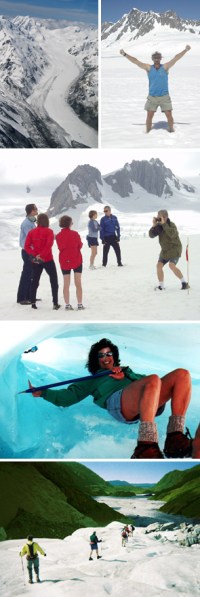
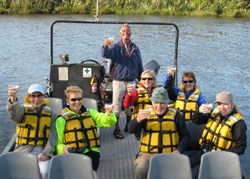
In the late afternoon we will head down to Okarito (either by van or by bike) for a lovely narrated boat tour of the lagoon, followed by optional hikes or beach-walking, before we all gather for a BBQ dinner. This small peaceful coastal hamlet is located on a small sand spit which divides the Tasman Sea from the Okarito Lagoon. The Lagoon is NZ’s largest unmodified wetland, an intricate ecosystem of shallow water and tidal flats surrounded by rainforest. Over 70 species of bird are found here, including the kiwi and the rare white heron (Kotuku). Keri Hulme’s Booker Prize-winning best seller, The Bone People, is set in this unpeopled region. The reclusive author is one of a few permanent residents in Okarito, along with our not-so-reclusive hosts Paula & Swade.
On Day 11 we cycle past several more teal-colored glacial rivers, but soon say goodbye to the World Heritage Area and its tropical-looking temperate rainforest. Our next destination is Hokitika, which is internationally renowned as a centre for creative arts. Visit the downtown area for the various art and craft shops dealing in gold and copper, glass blowing, whale bone and shell carving, wood works, and art photography.

For hundreds of years the Hokitika area has been an important source of pounamu (greenstone, or NZ jade) for the Māori people, for whom it is of great cultural and spiritual value, and is considered to have mana (status) and to be tapu (sacred). It is considered a taonga (great treasure)—much like the rest of the world values gold—but is also well suited to making tools, weapons and personal ornaments. Today you can see the craftsmen work the stone into jewelry, figurines, and Māori carvings. And of course you might just need to buy some final souvenirs of your trip!

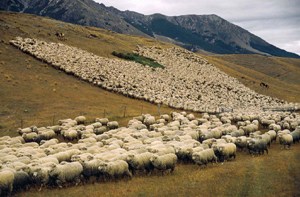
Alas we have come to our last day, Day 12. It is time to leave the West Coast behind and head inland towards the breathtaking Southern Alps. Just before it starts to get unbelievable steep the van scoops us up and takes us over the summit. For our final nights’ destination we are treated to another stay at the Wilderness Lodge, this time at Arthur’s Pass. Nestled in mountain beech forest, this deluxe Lodge is situated on a 5,900-acre nature reserve and merino sheep station. It’s time to savor one last walk in the pristine wilderness of New Zealand, as we watch their sheep dogs in action, help hand-feed their lambs, and discover how their wool ended up in our Smartwool socks. Our final nights’ dinner will be one to remember, as we toast our 13-day smorgasbord of unbelievable experiences. The following morning we will drag you, kicking and screaming, back to Christchurch airport for your flight back to the States.

